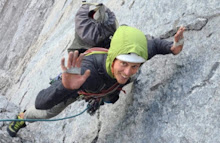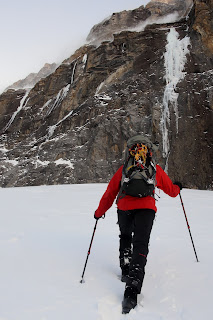February 13, 2019:
Fetching a knife blade from my harness, I probed the tip of it along the seam in front of me, but everywhere the seam looked promising, it seemed to bottom out. My crampon tips were stemmed out on either side of the water-worn groove, and sustaining enough body tension to swap hands on my ice tool, shake out, and replace the pin several times was mildly exhausting. Having explored what was within reach, I placed the pin and climbed onward resolving not to weight it.
A little higher, I excavated a notch for a finger-sized cam and although it too, looked far from bomber I was now within reach of the next ledge. I quieted my mind of doubt and scratched my tool in the snowed up kitty litter of the ledge until it found purchase. Stepping my feet higher, I mantled up on the ledge, but just as I bumped my foot, the tool sheared out from the choss and I was airborne.
Starting up pitch six, unaware of how spicy things were going to become. Photo: Ethan Berman.
Having ripped both pieces, I came to rest on the ropes, eight-millimetres diameter stretching to their full extent. I looked over at my partner Ethan Berman, just left of me at the belay, demanding me to secure my headlamp, which was now dangling precariously from my helmet. I had clearly taken quite a fall, some twenty-five metres. My shoulder had impacted the wall and was in a lot of pain, but I was otherwise fine. We communicated briefly on the phone with parks safety, who encouraged us to take a rescue, but we felt confident in our ability to get down and Ethan led the rappels smoothly to the base of the wall, shouldering the extra backpack to make the descent easier for me. An x-ray would reveal a fractured scapula, my arm was put in a sling for three weeks, and another four weeks beyond that was spent resting, recovering and developing a stronger sense of patience.
May 3, 2019:
Having clocked only a few days on the sharp end of a rope since the injury, I found myself ready for action, back at the base of my nemesis pitch in the afternoon. What ought to have been a moderate new route completed in just a couple of outings (or so my ego would have me believe,) had turned into a project. It had begun after all, in December and it was now May. It was now my fourth partner, and fifth outing up the buttress that was split by a long crack feature on the North Face of Lawrence Grassi. It was just as well, because each time I had bailed from high up on this route, I got to re-climb a number of quality pitches, including the direct start dagger, that had formed the previous fall. Good training, I suppose. On this morning however, Ryan Richardson and I had eschewed the alpine starts of winter and hiked through the dog park below the face in mid-morning, bumping into our friend Adam Campbell on the way who was gearing up for a day of peak-bagging on skis. Passing dog walkers, mountain bikers and wedding photographers, curious glances were directed our way. I felt as though this was an authentic Canmonix experience: The town's pedestrians and mountain-goers alike, crossing paths in approach of the day's intended objectives, the activities of our day-to-day lives imbued with the true romance of the mountains. How does this idea of romance, or lust in one's activity correlate to an ongoing saga with multiple partners? How does the day of the previous attempt (Valentine's Day) relate to this perverse activity of dry tooling, on a face named after a working class hero who swung an axe for a living and for fun, a face split by a feature that local climbers have lovingly referred to as "the town gash?" I chuckled to myself as a clever idea for a route name formed in my mind, and I filed it away to ponder later. A few hundred metres up the approach, we met the snow line and joined ski tracks from the fan of miners gully, eventually arriving at the base of the direct start dagger. Deciding that the dagger-to-curtain looked too sketchy after the recent heat wave had melted out most of it, we slogged around it and began up the first two and a half pitches that are shared with "Tainted Love." (Slawinski-Simon-Henriquez, Nov 2015.) After these pitches, the route veers away from the bolts of the storied "town gash", up a buttress split by a chimney. This is where the dirty fun of "Canmore Swingers Party" begins, the feature offering natural protection along the way, and sometimes just enough, through a variety of cracks.

The direct M7 WI5 start, climbed in winter on the prior attempts but not on the first ascent. Photo: Ethan Berman.
I had given the "money pitch" to Ryan, the selling point of the route for his needed partnership. The pitch is an undeniably fun and well-protected M6+ chimney/groove that narrowed to fist jams through a crux bulge. Ryan gave some effort and on-sighted the pitch, and the cumulative energy was high as I met him at the belay. I followed up with a pitch of wandering M6, the rock quality and protection questionable in places, keeping the focus level high. The psychological crux pitch above was now my lead, and I had been afforded plenty of time to ponder my experience with it. Now, armed with a bigger rack and the knowledge of what lie ahead, I moved with confidence and control into the pitch without the trepidation that had been lingering in my mind, knowing that this time would inevitably come. I climbed through a crux bulge, and above the mid-pitch snow patch, I clipped the angle piton that had caught my fall. It was without a doubt bomber, and reminded me that age-old piton craft is still key for new routing in the rockies. Further up, I equalized two totems (a marvel of modern Spanish engineering that are suited for less than ideal placements) clipped to a screamer in case I blew the exit moves from the groove again. I exited the groove without incident and trudged up another section of snow to a stance below the next section of rock. Here, a fridge sized obelisk of grey stone offered the perfect sling anchor for the final pitch.
Ryan arrived at the belay as the sun was setting. I told him my idea for the route's name, and we had a good laugh about it. We were after all, living in a town, and climbing a face that is famous for the swinging of axes - both pickaxes wielded by coal miners, and climbing axes as well. We fired off a few jokes about the variety and quality of cracks one might find at a Canmore Swingers' party, as you never know what to expect when you attend one. And here we were, at the swingers' party.. amongst the variety. I handed him the rack and he took off on the final pitch: a solid band of smoky-grey limestone, cut by a 5.9 off-width corner. He bumped our solitary number four Camelot, then hooked and mantled over a giant chock stone. The rope then slowed to a creep from my belay device for an hour as Ryan tunnelled up through a steep ledge of deep, unsupportive snow to surmount a final rock step. I hunkered down in the dark as constant wet spindrift poured over me. Ryan completed the pitch and put me on belay. I climbed as quick as I could, and joined Ryan at the anchor, both of us damp to our base layers from the snow and exertion. In the darkness our headlamps shone over a short snow ramp that lead to a cornice right above us. Reasoning against tunnelling into the cornice, as the true summit would be of no significance to the route, we pounded in a couple of pins and made quick work of the rappels, relishing in our little success before a civilized two-hour plod back to town.
First Ascent of "Canmore Swingers Party" 300m, M6+R, 5.9 WI3
Lawrence Grassi North Face, May 3, 2019 by Niall Hamill and Ryan Richardson.
The "Canmonix Sit-start" (M7 WI5, 40m) was climbed in winter but not on the first ascent.
(Pitch 1-2 as for "Tainted Love" by Slawinski-Simon-Henriquez, Nov 2015.)
Special thanks to Ethan Berman, Simon Bosse, and Will Skea for their partnership in earlier attempts.
Recommended rack: 12-14 slings, 2 screamers, 2 stubby ice screws, single rack from 0.2-#4, doubles 0.5-#2, single set wires, pitons. (bring extra screws if direct start is in)
1)
40 m, WI3 M4. Climb low-angled ice to a snow ledge. If the ice is thin, some stubbies and cams may be reassuring. Pass a 2-bolt rappel station on your left and drytool up a bolt-protected corner on the right. 2-bolt belay on the left wall.
2)
40 m, M5. Climb the left-facing corner above the belay (ignore a single bolt out left from an earlier attempt). A couple of steeper moves lead to an insecure exit. Slog up snow to a 2-bolt station at the top of the gully above. This pitch is all bolt protected.
3)
40 m, M3R. Step down and right from the belay (#1 Camalot placement) and climb a short groove. Clip a fixed pin in the back of the groove and commit to easy but runout moves left and up. Slog up a small snowfield, traversing right to the next gully feature, follow this (easy, runout) to a stance with fixed wires left by a previous parties' attempt in a small cave below the chimney.
4) 40m M6+. Steep moves off the belay with good gear and hooks lead to a fixed angle. A second crux comes higher through a steep bulge with a fixed red wire. Follow the groove to a bolted stance.
5) 40m M6. Follow the groove as it traverses left above the belay. Be wary of the rock here as it deteriorates slightly. Follow the groove to a sheltered belay stance out left below a steep bulge of loose blocks with a fixed pin, wire and pecker.
6) 40m M6R. Step down and right of the belay and back into the groove. The first of two cruxes is better protected than the second, be mindful of gear placements and save at least one screamer for the runout above the snow patch. A fridge shaped boulder provides anchor.
7) 50m 5.9 M5+. Climb the left-facing off width at 5.9 (#4, chock stone) or dry tool around it. A snow ledge separates the second step of the pitch, find a two-pin anchor above.
Canmonix in winter. Ethan Berman approaches Lawrence Grassi's North face. Photo: Niall Hamill.
The twinkling lights of Canmore as observed from Canmonix. Photo: Ryan Richardson.
Heading back up in May, intent on completing the line. Photo: Ryan Richardson.
Ryan and myself, enjoying a spring day of "alpine mini-putt."
Following the "money pitch" Photo: Ryan Richardson.
Heading back up pitch six, for the "pink-point" as they say. Here I am clipping the gear that was left in-situ when Ethan and I pulled the rope to make a hasty retreat following a 25-metre, gear ripping fall in February. "Basically sport climbing!" Photo: Ryan Richardson.
Ryan heading up the final pitch, which began with this 5.9 wide crack. Photo: Niall Hamill.
Topped out. Photo: Ryan Richardson
"Canmore Swingers Party" in red, the direct start in blue. Continuing up the groove would be "Tainted Love" (Slawinski-Simon-Henriquez, Nov 2015.) The obvious weakness to the right of the red line is "The Hole" (Welsted-Mills-Lussier, Dec 2014.) rumoured to be un-repeated as of this publishing date. (May 2019) Photo: Will Skea
Canmoreswingersparty











































